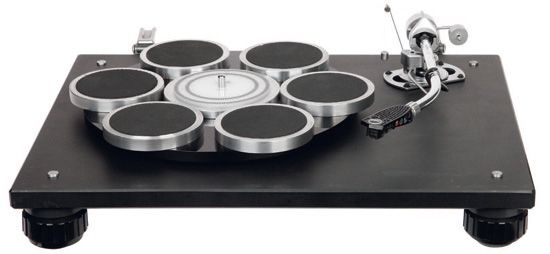JBE Series 3 (Vintage)

When JBE unveiled its Slatedeck in the late 1970s, it wasn’t just a turntable different for its time. It was a design that remains radical to this very day. Not only did its looks set it aside from its contemporaries (slightly Kubrick 2001 to our eyes) but it featured such niceties as a Japanese-sourced direct-drive motor system with a variable-pitch outboard electronic power supply – years before anyone else in the UK offered one at this price point.
Construction was also unique, the solid non-sprung plinth was either manufactured from clear plastic acrylic, or (in sonic preference and name) slate quarried from North Wales. The standard plinth measured 171⁄8x131⁄8in (wd), with larger ‘specials’ available for odd arms, such as the Dynavector.
Chunky ‘microsorber’ isolation feet were fitted to the plinth (again sourced from Japan), and a heavy acrylic lid helped complete the acoustic isolation.
The 1.9kg platter was a combination construction of more black acrylic, mass loaded with balanced aluminium ring ‘turrets’ sporting little foam cushions on top to support a record. Even the outboard power supply is quite a pretty piece, being housed in its own little black acrylic box.
The deck is beautifully made and finished, the lid fits perfectly, the control box operates smoothly and is well thought out, incorporating a very bright LED to act as a strobe lamp ‘torch’ for the strobe marks on the centre of the platter.
At launch the deck cost just £200, undercutting the Linn LP12 (£296) by a pretty large margin. It does not take a genius to work out that carefully machining a lump of Welsh slate, constructing a hybrid platter and building an outboard electronic power supply should have cost quite a bit more.
TABLE FOR TWO
Blessed in managing to find both acrylic and slate versions for auditioning purposes, we ended up listening with the same Grace G707 arm and cartridge combination, swapping the two between the decks. The cartridge was a an Ortofon 2M Black.
The first deck up was the acrylic, with the well trodden grooves of ABBA’s The Visitors LP. It was immediately apparent that the JBE had a very fast focus; percussion was tight but on this disc the sound lacked a little weight. Notes were replayed calmly and cleanly, though the delivery lacked a little gusto.
Switching to Jimmy Smith on Hammond, the weighty recording of ‘The Organ Grinder’s Swing’ balanced the deck’s attributes quite a bit better. Tonally this recording suited the fast presentation. The JBE acrylic has a real clarity about the midrange and treble. It was time to try the slate plinth model. Here the same discs gave subtly different results, and not all in the slate unit’s favour...
Vocal textures on the ABBA track had changed quite dramatically. Where the acrylic model seemed quite smooth and reserved, the slate version was harder, adding almost a chalky texture to Agnetha’s stunning vocal. However, drums were much more dynamic. There was an extra edge to this set up, more bang and more weight.
The Hammond disc sounded better on the slate version, enjoying an altogether fatter and more rounded presentation. On vocals, however, I was beginning to feel the acrylic plinth had a slight edge. Popping Marianne Faithfull’s ‘Broken English’ onto the all-slate deck swung the balance back for me, her vocal benefiting from the extra weight being added to her delivery. Of the two models, the sound of the slate plinth was better balanced. Nevertheless, the acrylic was much better than I had expected.
VERDICT
The JBE Slatedeck 3 combined state-of-the-art technology and an unconventional use of materials. Well made, good looking and with a totally respectable sound when care is taken with placement, either model makes a sound secondhand buy, even if the slightly upfront sound may come as a shock to some. Depite its low price when new, the deck unfortunately never earned the reputation it deserves.
Originally published in the Yearbook 2011


























































